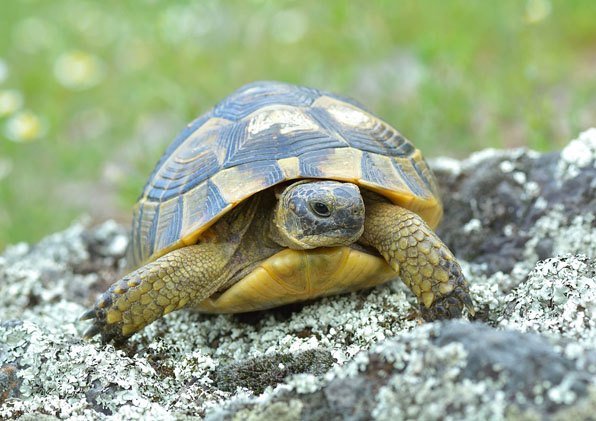
Understanding the Greek Tortoise’s Natural Habitat
To get a grip on their needs, it’s essential to understand where Greek tortoises come from. They thrive in areas with a Mediterranean climate, characterized by hot, dry summers and mild, wet winters. Imagine lounging on a beach with the sun shining down—this is the kind of warmth that makes these tortoises feel at home.
In their natural habitat, Greek tortoises bask in the sun and enjoy a wide range of temperatures throughout the day. They need to regulate their body temperature by moving between warm and cool areas. So, if you’re planning to keep them as pets, you’ll want to mimic this environment as closely as possible.
Ideal Temperature Ranges
Creating the right temperature for your Greek tortoise is like adjusting your home thermostat for comfort. They thrive best in a temperature range of 75°F to 95°F (about 24°C to 35°C) during the day. Let’s break this down further for you:
- Basking Area: This is the hotspot where your tortoise should bask. Aim for around 90°F to 95°F (32°C to 35°C). This heat helps them digest food and get essential vitamins.
- Cool Area: It’s just as important to have a cooler space for them to retreat to. Keep this around 70°F to 75°F (21°C to 24°C). They shouldn’t feel too hot all the time!
- Nighttime Temperature: At night, let the temperature drop a bit to about 65°F to 70°F (18°C to 21°C). This mimics their natural environment and helps them sleep better.
You might be wondering how to achieve these temperatures in your home. Using a combination of heat lamps, UVB light, and thermometers can help you maintain this balance.
The Role of Humidity
Humidity is another factor that plays a crucial role in your tortoise’s health. While Greek tortoises prefer drier conditions, they still need some level of humidity for proper hydration and to aid in shedding. Too much humidity, however, can lead to respiratory problems.
The ideal humidity level for a Greek tortoise should hover between 30% and 50%. To maintain this balance, consider these tips:
- Substrate: Use a mix of soil and sand to help retain moisture without making things soggy.
- Water Source: Providing a shallow water dish can help them drink and soak, increasing humidity around them without soaking their entire habitat.
- Monitoring: Use a hygrometer to keep track of humidity levels. Adjust as needed by misting a bit if it goes too low.
It’s about finding the sweet spot that keeps your Greek tortoise happy and healthy!
Creating a Comfortable Habitat
Now that we know the temperature and humidity needs, let’s look at how to create a comfortable habitat. You’re basically setting up a mini vacation home for your tortoise. Here’s what you need:
- Enclosure: Choose a spacious setup. A large outdoor pen or a spacious indoor terrarium will work. Just make sure it’s secure!
- Lighting: Invest in a good heat lamp and UVB light. These will help replicate natural sunlight and promote vitamin D3 synthesis.
- Hiding Spots: Add some rocks or tunnels where your tortoise can hide. This gives them a sense of security and a break from the heat.
Honestly, the more you customize it to keep the right conditions, the happier your tortoise will be. They’ll appreciate the effort!
Signs of Temperature or Humidity Stress
Even with the best intentions, things can sometimes go wrong. Knowing the signs of temperature or humidity stress is crucial. If your tortoise is feeling uncomfortable, they’ll let you know in subtle ways:
- Inactivity: If your tortoise is not moving around much, they could be too hot or too cold.
- Breathing Issues: Watch out for wheezing or open-mouth breathing. These can be signs of respiratory problems, often linked to humidity issues.
- Shell Problems: Soft or deformed shells can indicate improper humidity or nutrition. Keep an eye out!
If you notice any of these signs, don’t panic! Adjust the heating or humidity levels as needed, and consult with a vet if things don’t improve.
Seasonal Changes and Adjustments
Seasons change, and so should your tortoise’s habitat. In cooler months, you might need to raise the temperatures slightly to simulate the warmth they would naturally seek in their environment. You can do this by adjusting your heat lamps or even moving them indoors if needed.
During summer, watch the temperatures closely. If it gets too hot, ensure they have plenty of shade and cool areas to escape the heat. Always strive to keep their environment as balanced as possible!
Wrapping Up the Temperature and Humidity Journey
Understanding the temperature and humidity needs of the Greek tortoise might feel a bit overwhelming at first, but once you get the hang of it, it’s a breeze! You’re essentially creating a little slice of their Mediterranean paradise right at home. By providing the right conditions, you’ll ensure your tortoise lives a happy and healthy life.
Remember, it’s all about balance. Keep those basking spots warm, the cool areas inviting, and the humidity just right. With a bit of care and attention, your Greek tortoise will thrive—and you’ll have a lively companion to enjoy for years to come!

